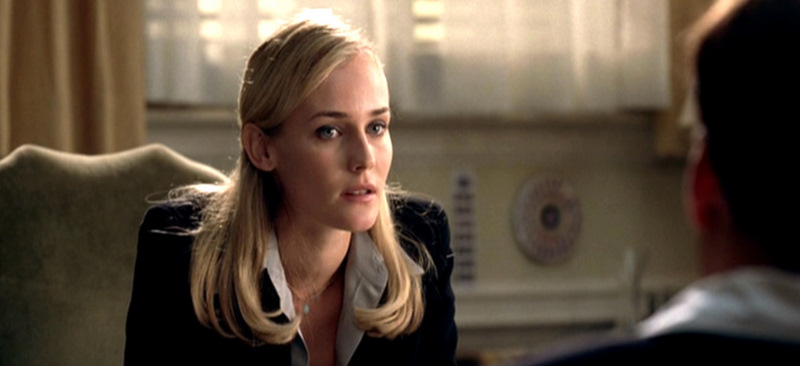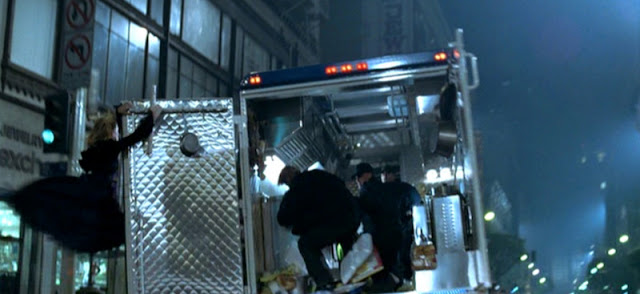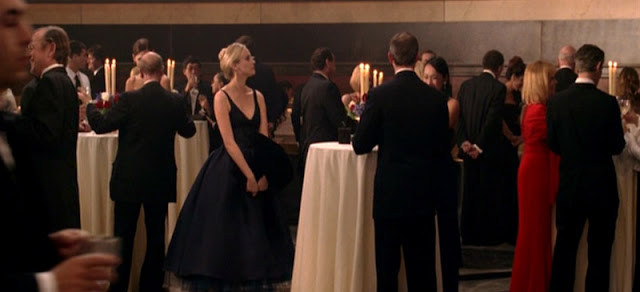 |
| Abigail Chase (Diane Kruger) in National Treasure |
 |
| Abigail in action hero mode |
 |
| Abigail’s stunning dress. LOVE IT, COVET. |
 |
| Abigail starts cooperating |
 |
| Ben disregarding Abigail’s safety |
The radical notion that women like good movies
 |
| Abigail Chase (Diane Kruger) in National Treasure |
 |
| Abigail in action hero mode |
 |
| Abigail’s stunning dress. LOVE IT, COVET. |
 |
| Abigail starts cooperating |
 |
| Ben disregarding Abigail’s safety |
Hailed by critics as a touching romance and one of the greatest animated films ever made, Beauty and the Beast became the first animated movie to be nominated for a Best Picture Oscar. When I watched it in the theatre years ago, I too fell under its spell, seduced by its lush animation, whimsical tunes and of course Belle.
It felt refreshing to see an intelligent, outspoken, animated heroine who loved to read. Outspoken and loved books? I was outspoken and loved books! I saw myself in Belle. She was a misunderstood misfit, wanting “more than this provincial life” to which she had been born. I too felt like an outcast, yearning for adventure and freedom. We were kindred spirits.
But it wasn’t until years later that I saw the crack in the veneer. As I got older and embraced myself as a feminist, I began to question things more diligently. Once you start to see sexism, you can’t NOT see it. Sadly, it’s everywhere, including children’s films. Actually it’s possibly most prevalent in children’s films, which often reinforce tired and oppressive gender roles and stereotypes.
Even though Belle possesses admirable traits, her merit still comes down to her looks. The Beast, Gaston, the villagers and the enchanted servants all exclaim she’s beautiful, gorgeous, pretty and “her looks have no parallel.” Girls and women should be valued for their intellect, skills and kindness. But no one in the movie is raving about Belle’s inner beauty. Not only is Belle stunning, which of course all Disney “princesses” must be, and white and thin (god we need some diversity in films). It’s her name. Her fucking name is “BELLE,” which in French means “beautiful!” Despite her intelligence and bibliophile ways, even her fucking name revolves around her looks. Once again, women are subjugated and reduced to their appearances. Disney says sure, it’s okay to be smart, bookish, even a weird outcast…as long as you’re pretty. Ugh.
The only other female characters in the movie are Mrs. Potts (I heart Angela Lansbury!), the wardrobe (who has no personality) and the French maid feather duster. A grandmotherly type and a sexpot. Of course Disney does their notorious matricide in the form of the protagonist’s mother either dead or non-existent. They demonize stepmothers and solely focus on both daughters’ and sons’ relationships with their fathers. Seriously, Disney, what the hell have you got against mothers?? And yep, I’m aware Mrs. Potts is Chips’s mother. Doesn’t count. Not only is she not Belle’s mother, she’s a fucking teapot for most of the film. Belle has no female friends, no mother, no sister, no female role model. The importance of female camaraderie and sisterly bonding remain absent from the film.
Unlike many female characters in animated films (or annoying rom-coms for that matter), Belle isn’t looking to be rescued or waiting around for her prince. Two reasons that make Belle a feminist in Woolverton’s eyes. Belle rejects the sexist chauvinist Gaston and his numerous marriage proposals, finding him “boorish” and “brainless.” She wants more out of life than shining that jerk’s boots and popping out his babies. But Belle rebuffs one dysfunctional suitor for another.
Sure, the sympathetic Beast eventually becomes nicer, giving Belle access to his library and letting birds treat him like a bird feeder. And I do like that Belle and the Beast become friends first before falling in love, which rarely happens in fairy tales. Except for one teeny tiny thing. He’s her captor. Falling in love with the guy who imprisons you, holds you hostage, tells you when to eat, where to go and doesn’t let you see your family?! That’s not love. That’s Stockholm Syndrome, sweetie.
I’ll admit Belle as a female character is a step in the right direction. She’s smart, stubborn, kind and ambitious. But Belle gives up her entire life to live forever in a castle with an asshat prince. What about her goals? Her dreams?? Oh that’s right. She becomes a princess! Yet another princess in the pantheon of princesses clogging up girlie-girl media.
Films and books reinforce gender roles and with a lack of female characters, imply that girls and women don’t count. Out of Disney’s 51 theatrically-released animated movies, only 13 feature a female character as a protagonist (16 if you count co-protagonists), most of them princesses. Princesses only care about their clothes and hair. Their looks matter more than their personalities. It seems society would rather teach girls to obsess over their appearance and how to snag a man.
Couldn’t Belle have opened up a bookshop/café or started a book drive or something?? When Belle sang about wanting “more than this provincial life,” I simply refuse to believe twirling around a ballroom in a pretty gown is what she had in mind.
I’m not going to lie. I still watch Beauty and the Beast, singing along to the songs. When I discovered Disney World was building a Beauty and the Beast themed restaurant and attraction, I admit I felt giddy with excitement. But look beyond the gorgeous animation, catchy show tunes and unique heroine.
Sadly, you’ll see yet another fabulous film tainted by sexism, spreading toxic messages that reinforce damaging beauty norms, violence against women and suffocating gender stereotypes.
Not all that glitters is gold. Unwrapping the beautiful package can sometimes yield an ugly core.
An intelligent, strong-willed, female protagonist. Who reads books. And seeks adventure. With a heroine like Belle, Disney’s Beauty and the Beast, must be a feminist-minded film. Right?? At first, I thought so too. But appearances can be deceiving…
Hailed by critics as a touching romance and one of the greatest animated films ever made, Beauty and the Beast became the first animated movie to be nominated for a Best Picture Oscar. When I watched it in the theatre years ago, I too fell under its spell, seduced by its lush animation, whimsical tunes and of course Belle.
It felt refreshing to see an intelligent, outspoken, animated heroine who loved to read. Outspoken and loved books? I was outspoken and loved books! I saw myself in Belle. She was a misunderstood misfit, wanting “more than this provincial life” to which she had been born. I too felt like an outcast, yearning for adventure and freedom. We were kindred spirits.
But it wasn’t until years later that I saw the crack in the veneer. As I got older and embraced myself as a feminist, I began to question things more diligently. Once you start to see sexism, you can’t NOT see it. Sadly, it’s everywhere, including children’s films. Actually it’s possibly most prevalent in children’s films, which often reinforce tired and oppressive gender roles and stereotypes.
Even though Belle possesses admirable traits, her merit still comes down to her looks. The Beast, Gaston, the villagers and the enchanted servants all exclaim she’s beautiful, gorgeous, pretty and “her looks have no parallel.” Girls and women should be valued for their intellect, skills and kindness. But no one in the movie is raving about Belle’s inner beauty. Not only is Belle stunning, which of course all Disney “princesses” must be, and white and thin (god we need some diversity in films). It’s her name. Her fucking name is “BELLE,” which in French means “beautiful!” Despite her intelligence and bibliophile ways, even her fucking name revolves around her looks. Once again, women are subjugated and reduced to their appearances. Disney says sure, it’s okay to be smart, bookish, even a weird outcast…as long as you’re pretty. Ugh.
The only other female characters in the movie are Mrs. Potts (I heart Angela Lansbury!), the wardrobe (who has no personality) and the French maid feather duster. A grandmotherly type and a sexpot. Of course Disney does their notorious matricide in the form of the protagonist’s mother either dead or non-existent. They demonize stepmothers and solely focus on both daughters’ and sons’ relationships with their fathers. Seriously, Disney, what the hell have you got against mothers?? And yep, I’m aware Mrs. Potts is Chips’s mother. Doesn’t count. Not only is she not Belle’s mother, she’s a fucking teapot for most of the film. Belle has no female friends, no mother, no sister, no female role model. The importance of female camaraderie and sisterly bonding remain absent from the film.
Unlike many female characters in animated films (or annoying rom-coms for that matter), Belle isn’t looking to be rescued or waiting around for her prince. Two reasons that make Belle a feminist in Woolverton’s eyes. Belle rejects the sexist chauvinist Gaston and his numerous marriage proposals, finding him “boorish” and “brainless.” She wants more out of life than shining that jerk’s boots and popping out his babies. But Belle rebuffs one dysfunctional suitor for another.
Sure, the sympathetic Beast eventually becomes nicer, giving Belle access to his library and letting birds treat him like a bird feeder. And I do like that Belle and the Beast become friends first before falling in love, which rarely happens in fairy tales. Except for one teeny tiny thing. He’s her captor. Falling in love with the guy who imprisons you, holds you hostage, tells you when to eat, where to go and doesn’t let you see your family?! That’s not love. That’s Stockholm Syndrome, sweetie.
I’ll admit Belle as a female character is a step in the right direction. She’s smart, stubborn, kind and ambitious. But Belle gives up her entire life to live forever in a castle with an asshat prince. What about her goals? Her dreams?? Oh that’s right. She becomes a princess! Yet another princess in the pantheon of princesses clogging up girlie-girl media.
Films and books reinforce gender roles and with a lack of female characters, imply that girls and women don’t count. Out of Disney’s 51 theatrically-released animated movies, only 13 feature a female character as a protagonist (16 if you count co-protagonists), most of them princesses. Princesses only care about their clothes and hair. Their looks matter more than their personalities. It seems society would rather teach girls to obsess over their appearance and how to snag a man.
Couldn’t Belle have opened up a bookshop/café or started a book drive or something?? When Belle sang about wanting “more than this provincial life,” I simply refuse to believe twirling around a ballroom in a pretty gown is what she had in mind.
I’m not going to lie. I still watch Beauty and the Beast, singing along to the songs. When I discovered Disney World was building a Beauty and the Beast themed restaurant and attraction, I admit I felt giddy with excitement. But look beyond the gorgeous animation, catchy show tunes and unique heroine.
Sadly, you’ll see yet another fabulous film tainted by sexism, spreading toxic messages that reinforce damaging beauty norms, violence against women, and suffocating gender stereotypes.
Not all that glitters is gold. Unwrapping the beautiful package can sometimes yield an ugly core.
Megan Kearns is a feminist vegan blogger, freelance writer and activist. She blogs at The Opinioness of the World, where she shares her opinions on gender equality, living cruelty-free, Ellen Ripley and delish vegan cupcakes. Her work has also appeared at Arts & Opinion, Fem2pt0, Italianieuropei, Open Letters Monthly, and A Safe World for Women. She earned a B.A. in Anthropology and Sociology and a Graduate Certificate in Women and Politics and Public Policy. Megan lives in Boston with more books than she will probably ever read in her lifetime.
Megan contributed reviews of The Girl with the Dragon Tattoo, The Girl Who Played with Fire, The Girl Who Kicked the Hornet’s Nest, Something Borrowed, !Women Art Revolution, Who’s Afraid of Virginia Woolf?, The Kids Are All Right (for our 2011 Best Picture Nominee Review Series), The Reader (for our 2009 Best Picture Nominee Review Series), Mad Men (for our Mad Men Week), Game of Thrones and The Killing (for our Emmy Week 2011), Alien/Aliens (for our Women in Horror Week 2011), and I Came to Testify, Pray the Devil Back to Hell and Peace Unveiled in Women, War & Peace series. She was the first writer featured as a Monthly Guest Contributor.